Spatial Suitability Evaluation of Livestock and Poultry Breeding: A Case Study in Wangkui County, Heilongjiang Province, China
Abstract
:1. Introduction
2. Materials and Methods
2.1. Study Area
2.2. Data Source and Collection
2.3. Spatial Suitability Evaluation Modelling
2.3.1. Evaluation Unit Division
2.3.2. Evaluation Index System Construction
2.3.3. Index Analysis and Calculation
- (1)
- Ec1 analysis method
- a.
- Manure nutrient supply of LPFs
- b.
- Manure nutrient requirements of evaluation units
- c.
- Manure nutrient allocation methods for LPF
- d.
- Manure nutrient acceptance method for an evaluation unit
- The accepts the of LPFs based on distance; the priority is to accept the of the nearest LPFs.
- The maximum radius of manure nutrient distribution is 2 km [12] and transport costs beyond 2 km exceed the manure price.
- When the has two or more LPFs with the same , the priority is to accept the of the LPFs that can saturate the of the .
- When the has two or more LPFs with the same and there are two or more LPFs such that the satisfies the demand of the , the priority is to accept the of the LPF with the highest .
- When the has two or more LPFs with the same and the remaining of all LPFs is lower than the of the , the priority is to accept the of the LPF with the highest remaining
- The maximum value of the sum of the is the of the . When the sum of the is less than the of the , it will continue to accept the of other LPFs in accordance with the first four principles. When the sum of the equals the of the , the of other LPFs will not be accepted.
- e.
- Soil fertility demand degree
- (2)
- Calculation methods of other indexes
2.3.4. Index Standardisation Method
- (1)
- Dimensionless transformation method
- (2)
- Weight calculation method
- (3)
- Standardised calculation method
2.3.5. Cluster Analysis of Evaluation Units
2.3.6. Suitability Ranking Analysis
2.3.7. Extraction of Suitable Breeding Zones
2.3.8. Space Optimisation of LPFs
3. Results
3.1. Original Value Results of Indexes
- Wangkui County has flat terrain, good soil texture, a relatively uniform distribution of water systems, and relatively developed roads. No large area of forest land exists in the county, and small areas of forest land are scattered.
- The proportion of cultivated land is large and the demand for soil fertility is high. The distance between the evaluation unit and the cultivated land is relatively short, which is suitable for returning livestock and poultry manure compost to the nearby field.
- Ecological and cultural land, such as protected areas and water sources, are scattered, and the distance between the evaluation unit and the ecological and cultural land is mostly within 5 km.
- There is one main urban area, which is located in the west of the county. Few and unevenly distributed farmers’ markets were observed.
- LPFs were relatively densely distributed in the main urban area.
3.2. Standardised Results of Indexes
3.3. Evaluation Unit Clustering Results
3.4. Suitability Ranking Results
3.5. Results of Suitable Breeding Zones
3.6. Space Optimisation of LPFs
4. Discussion and Conclusions
Supplementary Materials
Author Contributions
Funding
Institutional Review Board Statement
Informed Consent Statement
Data Availability Statement
Conflicts of Interest
References
- Qian, Y.; Song, K.; Hu, T.; Ying, T. Environmental status of livestock and poultry sectors in China under current transformation stage. Sci. Total Environ. 2018, 622–623, 702–709. [Google Scholar] [CrossRef]
- Liu, W.-R.; Zeng, D.; She, L.; Su, W.-X.; He, D.-C.; Wu, G.-Y.; Ma, X.-R.; Jiang, S.; Jiang, C.-H.; Ying, G.-G. Comparisons of pollution characteristics, emission situations, and mass loads for heavy metals in the manures of different livestock and poultry in China. Sci. Total Environ. 2020, 734, 139023. [Google Scholar] [CrossRef] [PubMed]
- Han, Z.; Han, C.; Yang, C. Spatial econometric analysis of environmental total factor productivity of ranimal husbandry and its influencing factors in China during 2001–2017. Sci. Total Environ. 2020, 723, 137726. [Google Scholar] [CrossRef]
- Jones, J.W.; Antle, J.M.; Basso, B.; Boote, K.J.; Conant, R.T.; Foster, I.; Godfray, H.C.J.; Herrero, M.; Howitt, R.E.; Janssen, S.; et al. Toward a new generation of agricultural system data, models, and knowledge products: State of agricultural systems science. Agric. Syst. 2017, 155, 269–288. [Google Scholar] [CrossRef] [PubMed]
- Yan, B.J.; Li, Y.X.; Yan, J.J.; Shi, W.J. Spatial site selection for a centralized treatment center of livestock excreta: Taking Nantong Town as an example. Comput. Electron. Agric. 2021, 180, 105885. [Google Scholar] [CrossRef]
- Yan, B.; Shi, W.; Yan, J.; Chun, K.P. Spatial distribution of livestock and poultry farm based on livestock manure nitrogen load on farmland and suitability evaluation. Comput. Electron. Agric. 2017, 139, 180–186. [Google Scholar] [CrossRef]
- Yang, N.; Chen, L.; Wang, W.; Shen, Z. The land carrying capacity and environmental risk assessment of livestock and poultry breeding considering crop planting. Environ. Sci. Pollut. Res. 2021, 28, 51356–51368. [Google Scholar] [CrossRef]
- Meng, X.; Zhou, H.; Zhang, J. Spatial and temporal characteristics and EKC verification for livestock pollution. J. Arid Land Resour. Environ. 2015, 29, 104–108. [Google Scholar] [CrossRef]
- Hollings, T.; Robinson, A.; van Andel, M.; Jewell, C.; Burgman, M. Species distribution models: A comparison of statistical approaches for livestock and disease epidemics. PLoS ONE 2017, 12, 19. [Google Scholar] [CrossRef] [Green Version]
- Chen, G.; Cao, H.; Ding, T.; Huo, W.; Pan, Y. Bearing Capacity of Livestock and Poultry Manure in Huang-Huai-Hai Region Based on Nitrogen and Phosphorus Farmland Utilization. J. Ecol. Rural Environ. 2021, 37, 714–723. [Google Scholar] [CrossRef]
- Yue, Z.; Huasheng, H.; Wenzhi, C.A.O.; Weiping, W.; Nengwang, C. GIS and BEHD based Farm Manure Evaluation and Its Spatial Optimization. Resour. Sci. 2006, 28, 25–29. [Google Scholar] [CrossRef]
- Wen, J.; Zhen, B.; Pu, Z.; Peng, X.; Tan, J.; Shao, Z.; Bao, B.; Ran, Z.; Gao, Q.; Deng, B. An improved method used for evaluating potential environmental pollution risk based on spatial distribution and density of farms. Environ. Sci. Pollut. Res. 2021, 28, 10564–10575. [Google Scholar] [CrossRef] [PubMed]
- Qiu, L.; Zhu, J.; Pan, Y.; Hu, W.; Amable, G.S. Multi-criteria land use suitability analysis for livestock development planning in Hangzhou metropolitan area, China. J. Clean. Prod. 2017, 161, 1011–1019. [Google Scholar] [CrossRef]
- Won, S.; Ahmed, N.; You, B.-G.; Shim, S.; Kim, S.-S.; Ra, C. Nutrient production from Korean poultry and loading estimations for cropland. J. Anim. Sci. Technol. 2018, 60, 3. [Google Scholar] [CrossRef] [Green Version]
- Wang, Y.; Pan, F.; Chang, J.; Wu, R.; Tibamba, M.; Lu, X.; Zhang, X. Effect and Risk Assessment of Animal Manure Pollution on Huaihe River Basin, China. Chin. Geogr. Sci. 2021, 31, 751–764. [Google Scholar] [CrossRef]
- Yan, B.; Yan, J.; Shi, W. Estimation of carrying capacity of livestock farm based on maximum phosphorus load of farmland and GIS spatial analysis technology. Curr. Sci. 2017, 112, 1931–1936. [Google Scholar] [CrossRef]
- Ouyang, W.; Hao, F.H.; Wei, X.F.; Huang, H.B. Spatial and temporal trend of Chinese manure nutrient pollution and assimilation capacity of cropland and grassland. Environ. Sci. Pollut. Res. 2013, 20, 5036–5046. [Google Scholar] [CrossRef]
- Li, J.; Liu, L. Determining the carrying capacity and environmental risks of livestock and poultry breeding in coastal areas of eastern China: An empirical model. Environ. Sci. Pollut. Res. 2020, 27, 7984–7995. [Google Scholar] [CrossRef]
- Li, Y.; Yan, B.; Yan, J.; Shi, W. Estimation of Carrying Capacity of Livestock and Poultry Based on RS and GIS: A Case in Minhou County, Fuzhou City. Pol. J. Environ. Stud. 2021, 30, 227–234. [Google Scholar] [CrossRef]
- Peng, L.H.; Chen, W.W.; Li, M.; Bai, Y.; Pan, Y.P. GIS-based study of the spatial distribution suitability of livestock and poultry farming: The case of Putian, Fujian, China. Comput. Electron. Agric. 2014, 108, 183–190. [Google Scholar] [CrossRef]
- Wu Kening, Z.R. Soil texture classification and its application in China. Soil J. 2019, 56, 227–241. [Google Scholar] [CrossRef]
- HJ/T 81—2001; PRC Technical Standard of Preventing Pollution for Livestock and Poultry Breeding. Ministry of Ecology and Environment: Beijing, China, 2001.
- Kohonen, T. Self-Organizing Maps; Springer: New York, NY, USA, 2001; Volume 30, Available online: https://h-s.link.springer.com.neau.vpn358.com/chapter/10.1007/978-3-642-56927-2_3 (accessed on 26 April 2022).
- Buckland, M. Kohonen’s Self Organizing Feature Maps; Springer: Berlin/Heidelberg, Germany, 2003; Available online: http://www.ai-junkie.com/ann/som/som1.html (accessed on 26 April 2022).
- Ni, M.; Cheng, H.; Lai, J. GAN-SOM: A clustering framework with SOM-similar network based on deep learning. J. Supercomput. 2021, 77, 4871–4886. [Google Scholar] [CrossRef]
- Czyzewska, M.; Szkola, J.; Pancerz, K. Towards Assessment of Innovativeness Economy Determinant Correlation: The Double Self-Organizing Feature Map Approach. Fundam. Inform. 2014, 129, 37–48. [Google Scholar] [CrossRef]
- Liu, B.L.; Li, G.; You, H.; Sui, M.R. Assessment of the surface water quality ranking in Mudan River using multivariate statistical techniques. Water Sci. Technol.-Water Supply 2015, 15, 606–616. [Google Scholar] [CrossRef]
- Pham, H.V.; Cooper, E.W.; Cao, T.; Kamei, K. Hybrid Kansei-SOM model using risk management and company assessment for stock trading. Inf. Sci. 2014, 256, 8–24. [Google Scholar] [CrossRef]
- Olkowska, E.; Kudłak, B.; Tsakovski, S.; Ruman, M.; Simeonov, V.; Polkowska, Z. Assessment of the water quality of Kłodnica River catchment using self-organizing maps. Sci. Total Environ. 2014, 476–477, 477–484. [Google Scholar] [CrossRef]
- Kudłak, B.; Tsakovski, S.; Simeonov, V.; Sagajdakow, A.; Wolska, L.; Namieśnik, J. Ranking of ecotoxisity tests for underground water assessment using the Hasse diagram technique. Chemosphere 2014, 95, 17–23. [Google Scholar] [CrossRef]
- Quintero, N.Y.; Bruggemann, R.; Restrepo, G. Ranking of 38 prokaryotes according to their uranium uptake capacity in aqueous solutions: An approach from order theory through the Hasse diagram technique. Toxicol. Environ. Chem. 2017, 99, 1242–1269. [Google Scholar] [CrossRef]
- Brüggemann, R.; Patil, G. Partial Order and Hasse Diagrams. In Ranking and Prioritization for Multi-indicator Systems; Environmental and Ecological Statistics; Springer: New York, NY, USA, 2011; pp. 13–23. Available online: http://h-s.link.springer.com.neau.vpn358.com/chapter/10.1007/978-1-4419-8477-7_2 (accessed on 26 April 2022).
- Brüggemann, R.; Münzer, B. A graph-theoretical tool for priority setting of chemicals. Chemosphere 1993, 27, 1729–1736. [Google Scholar] [CrossRef]
- Voigt, K.; Brüggemann, R.; Pudenz, S. A multi-criteria evaluation of environmental databases using the Hasse Diagram Technique (ProRank) software. Environ. Model. Softw. 2006, 21, 1587–1597. [Google Scholar] [CrossRef]
- Voyslavov, T.; Tsakovski, S.; Simeonov, V. Surface water quality assessment using self-organizing maps and Hasse diagram technique. Chemom. Intell. Lab. Syst. 2012, 118, 280–286. [Google Scholar] [CrossRef]
- Voyslavov, T.; Tsakovski, S.; Simeonov, V. Hasse diagram technique as a tool for water quality assessment. Anal. Chim. Acta 2013, 770, 29–35. [Google Scholar] [CrossRef] [PubMed]
- Carlsen, L.; Bruggemann, R.; Sailaukhanuly, Y. Application of selected partial order tools to analyze fate and toxicity indicators of environmentally hazardous chemicals. Ecol. Indic. 2013, 29, 191–202. [Google Scholar] [CrossRef]

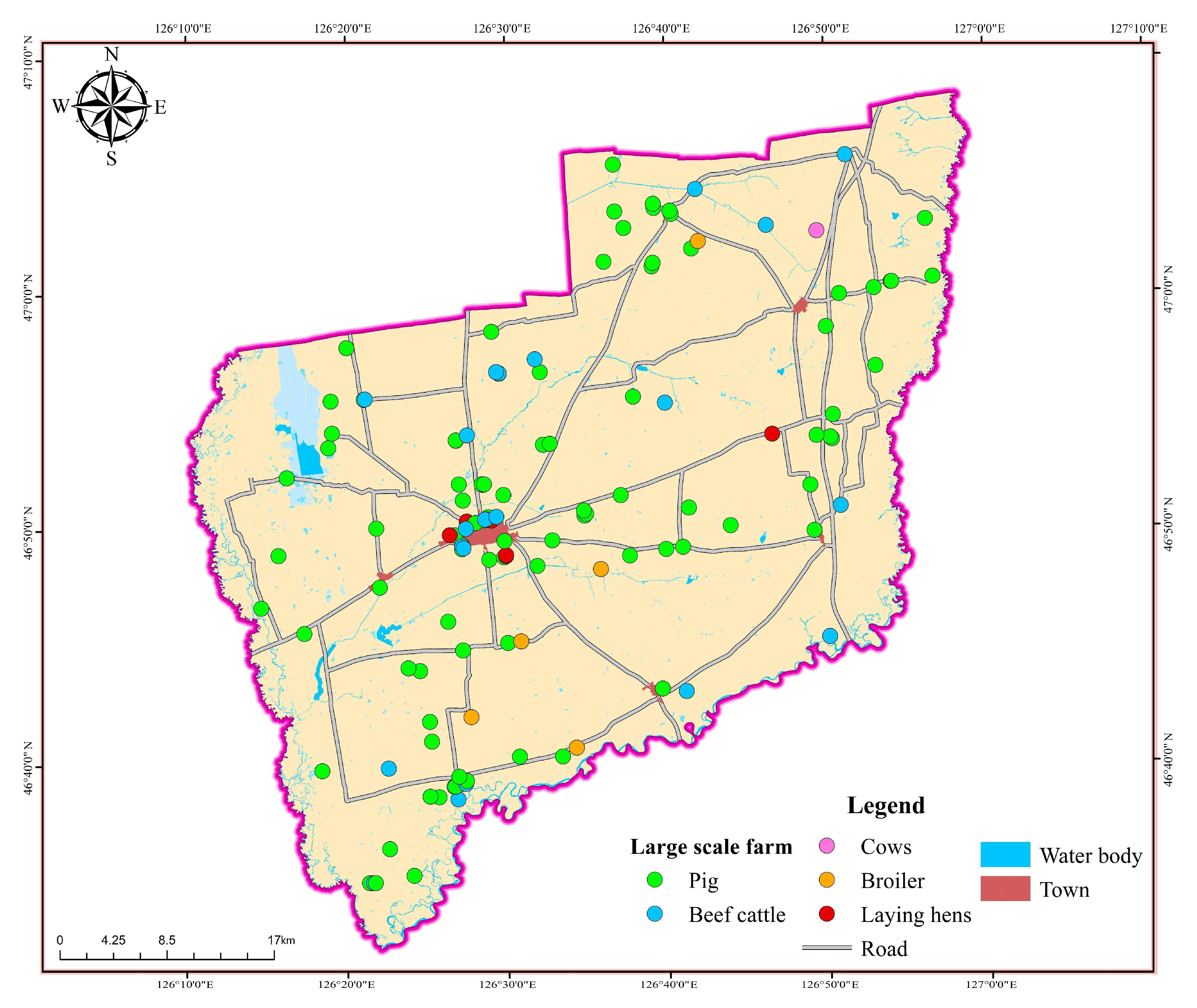
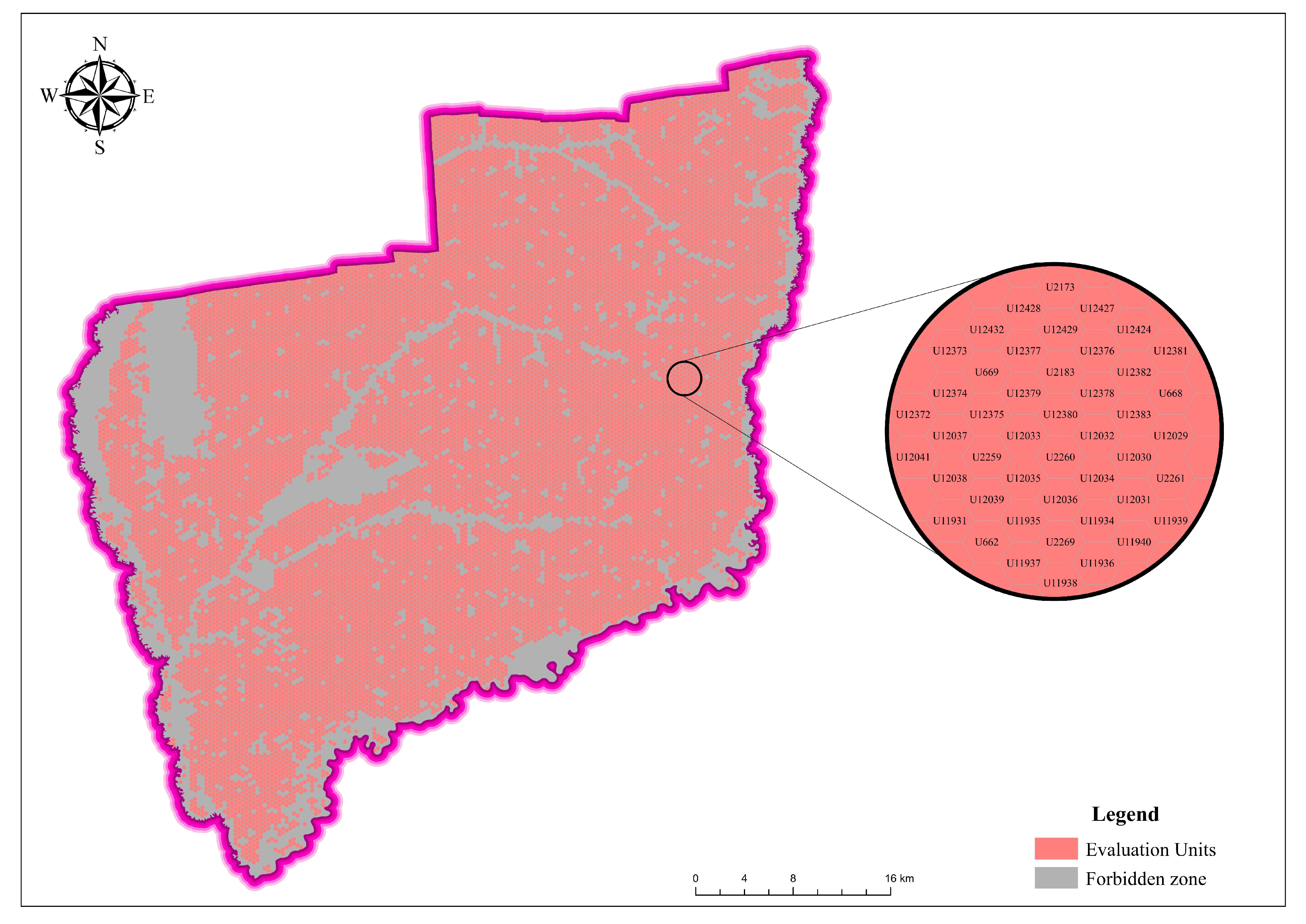
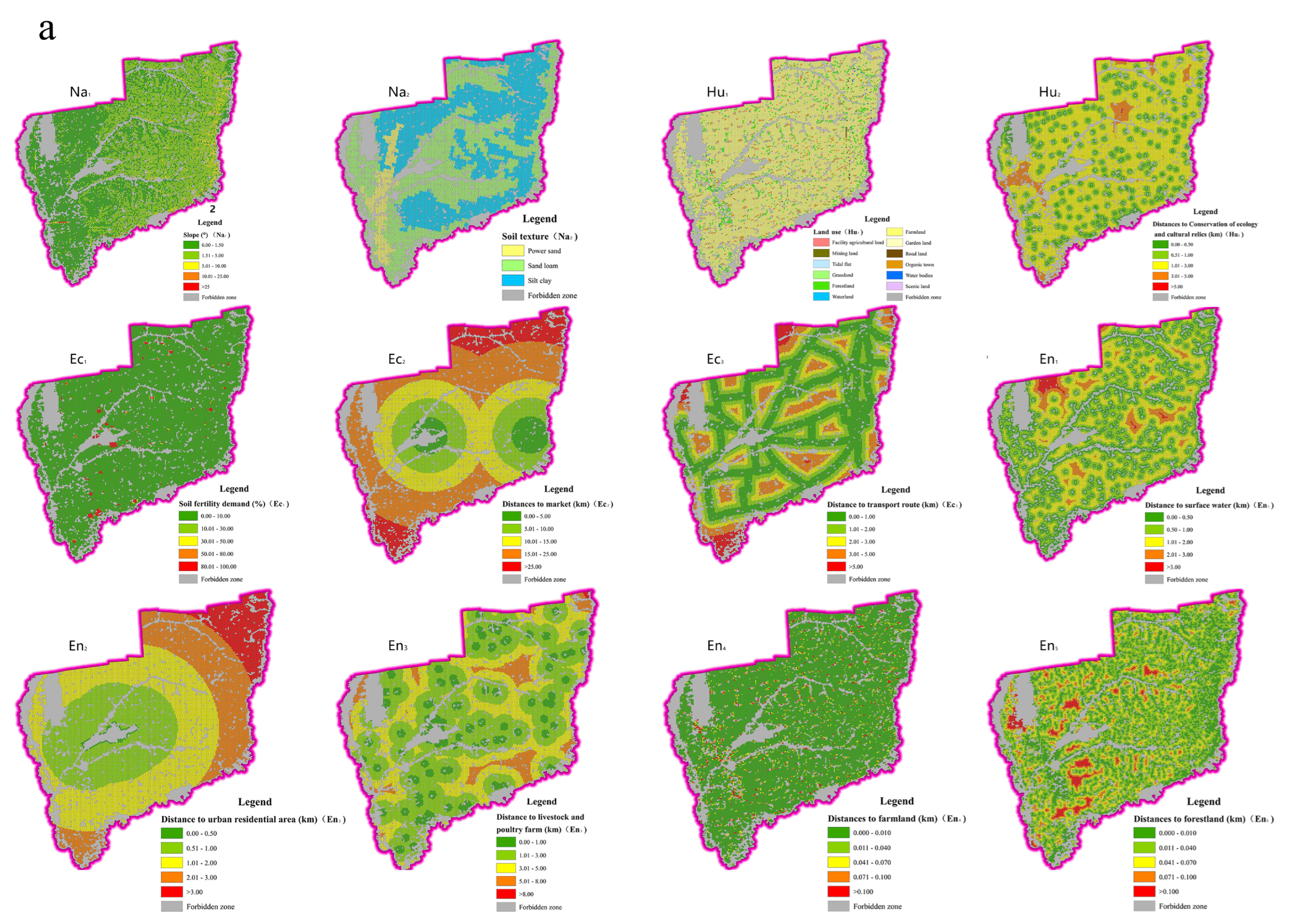
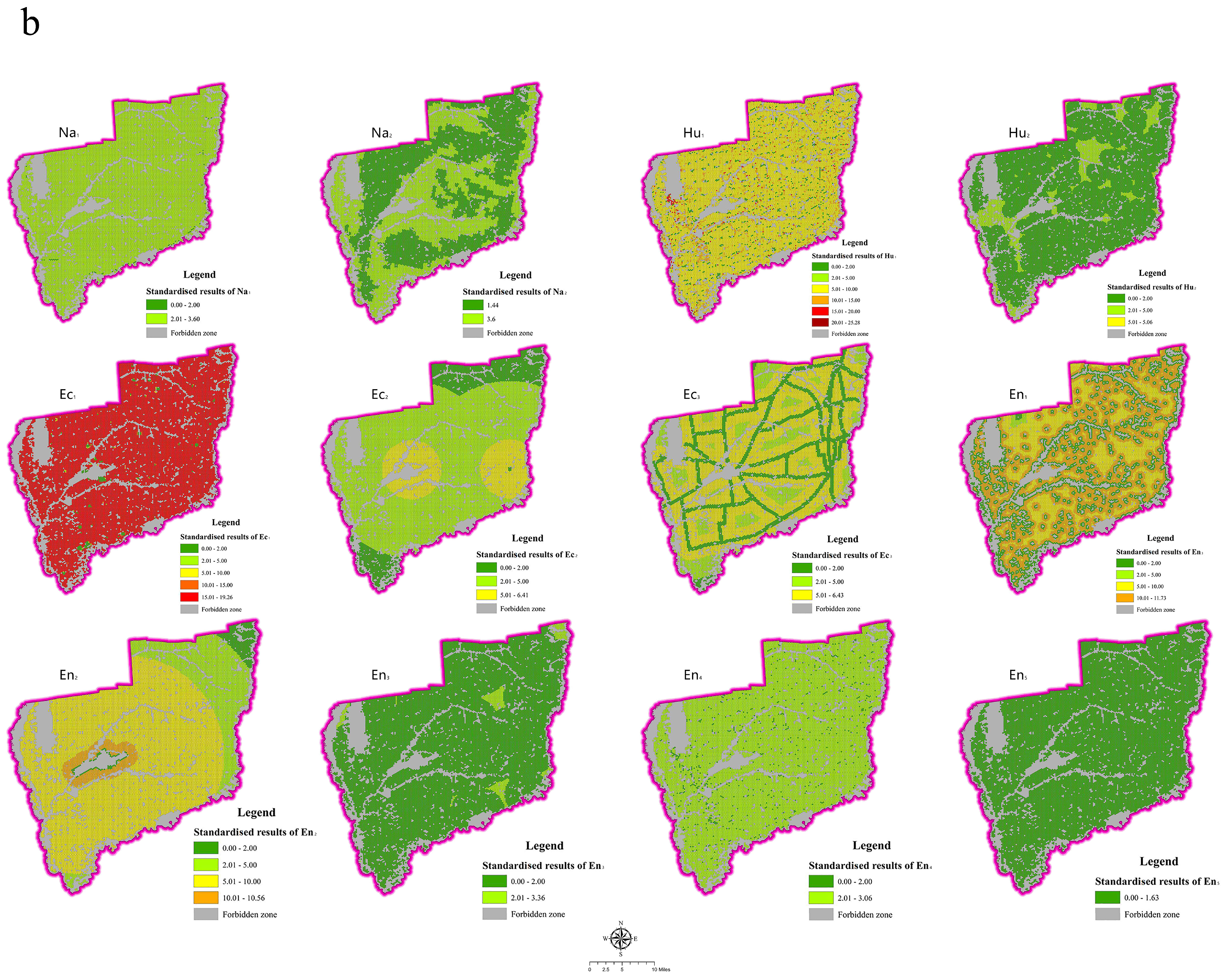

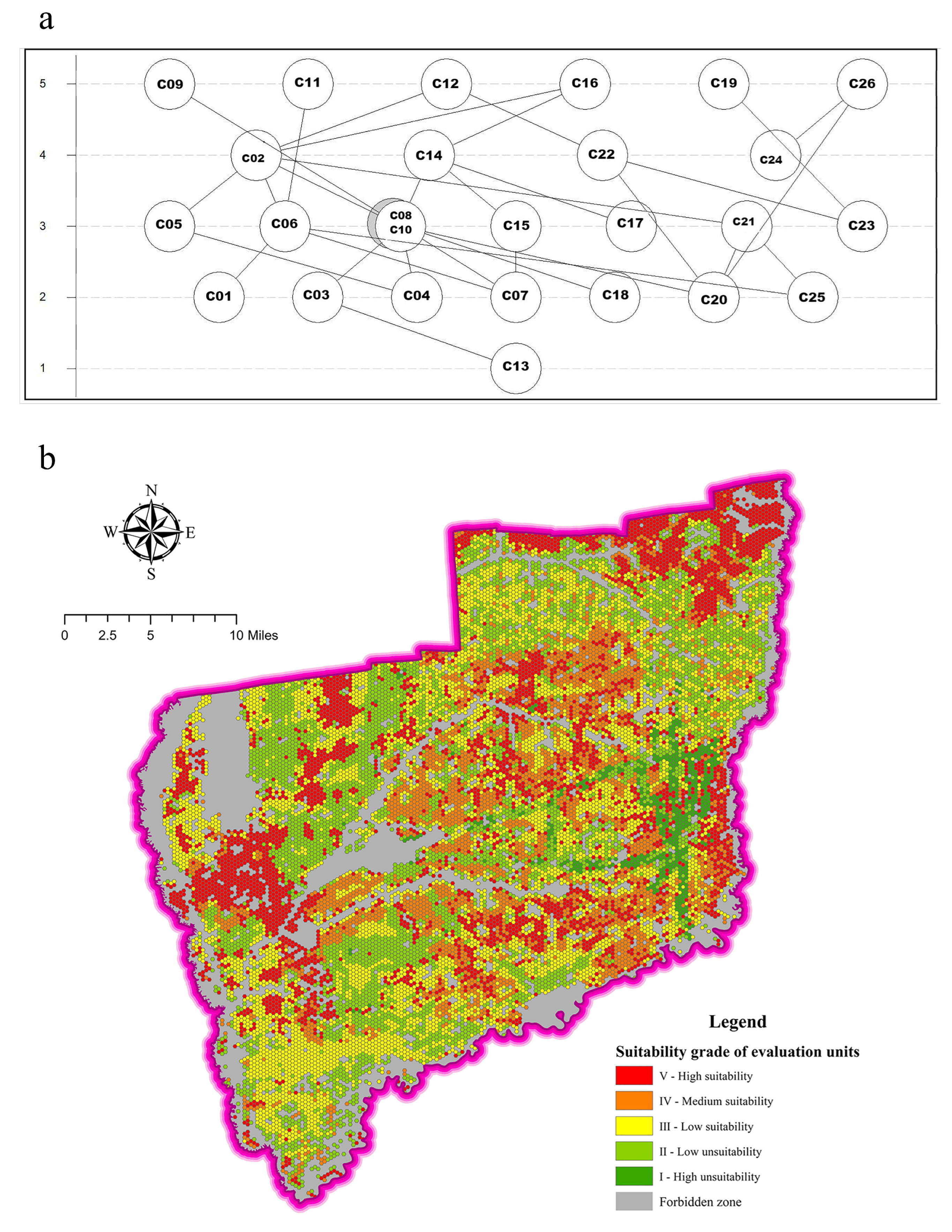
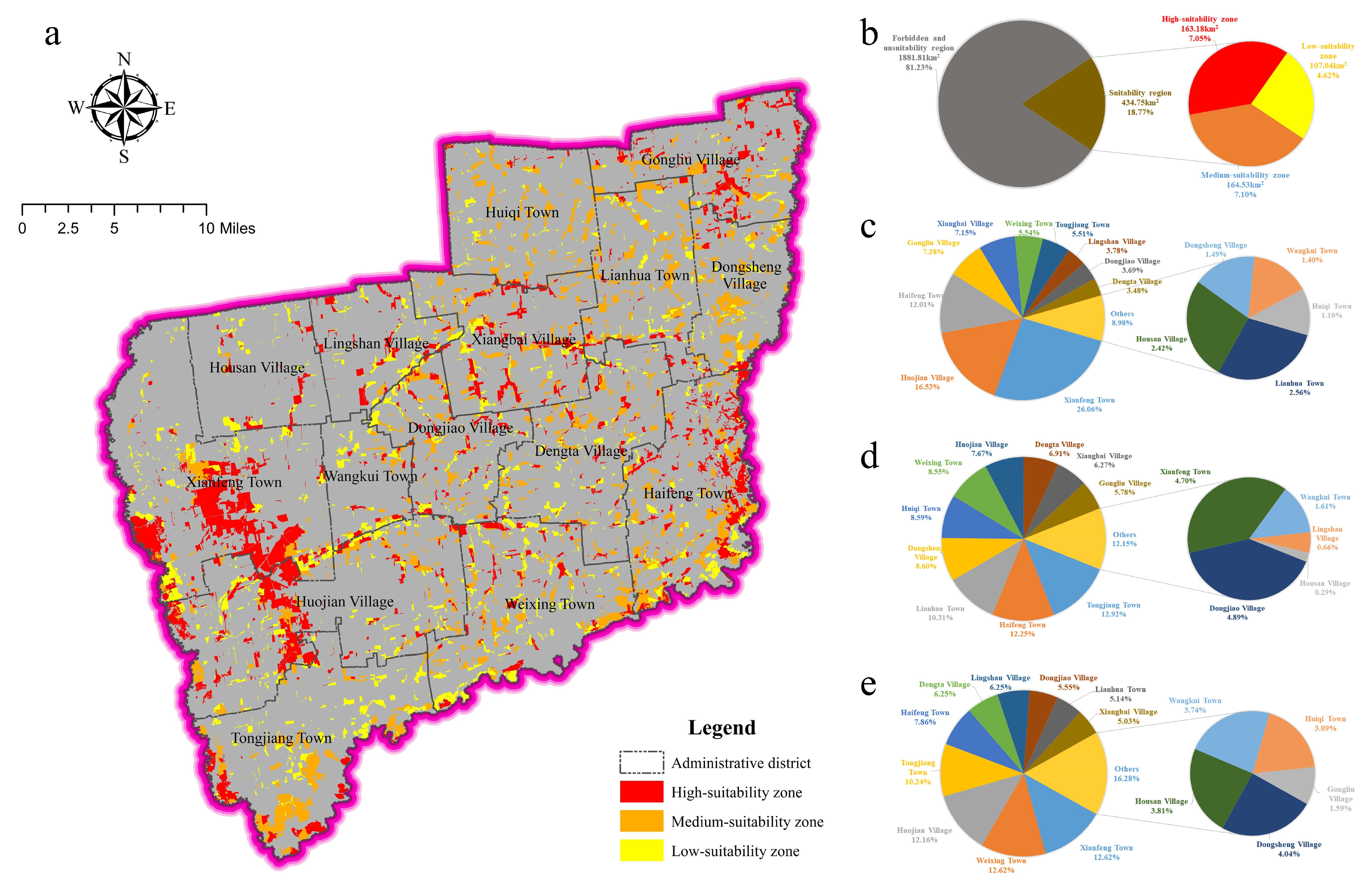
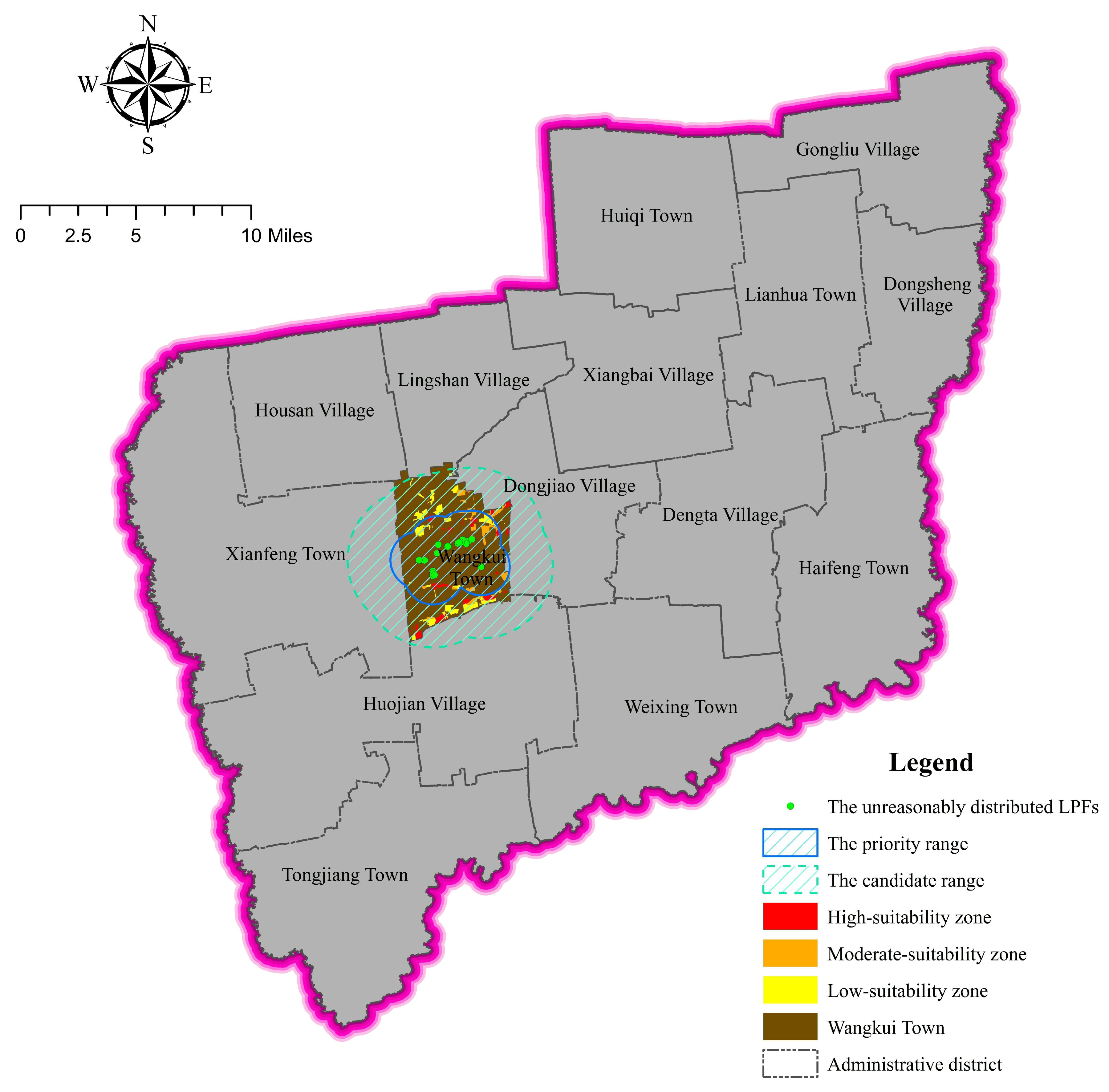
| Object Layer | Function Layer | Index Layer |
|---|---|---|
| Suitability of LPB (S) | Natural factor (Na) | Slope (°) (Na1) |
| Soil texture (Na2) | ||
| Human factor (Hu) | Land use (Hu1) | |
| Distances to Conservation of ecology and cultural relics (Hu2) | ||
| Economic factor (Ec) | Soil fertility demand (Ec1) | |
| Distances to market (Ec2) | ||
| Distance to transport route (Ec3) | ||
| Environmental factor (En) | Distance to surface water (En1) | |
| Distance to urban residential area (En2) | ||
| Distance to LPF (En3) | ||
| Distances to farmland (En4) | ||
| Distances to forestland (En5) |
| Index Layer | Classification Grading Layer | |||||
|---|---|---|---|---|---|---|
| Na1 | Na1 < 2 | 2 ≤ Na1 < 5 | 5 ≤ Na1 < 10 | 10 ≤ Na1 < 15 | 15 ≤ Na1 < 25 | Na1 ≥ 25 |
| Na2 | Sandy loam | Silt, Clay loam | Sand silt, Sand clay | Powder sand, Silt clay | fine sand, Loam clay | coarse sand, Clay, Heavy clay |
| Hu1 | Facility agricultural land, Mining land | Waterland | Grassland | Forestland | Garden land, Farmland, | Organic town, village, Water bodies, Road land, Scenic land |
| ) | 100 | 80 | 60 | 40 | 20 | 0 |
| Serial Number | Index Layer | Weights | Serial Number | Index Layer | Weights |
|---|---|---|---|---|---|
| 1 | Na1 | 0.036 | 7 | Ec3 | 0.0643 |
| 2 | Na2 | 0.036 | 8 | En1 | 0.1173 |
| 3 | Hu1 | 0.2528 | 9 | En2 | 0.1056 |
| 4 | Hu2 | 0.0506 | 10 | En3 | 0.0336 |
| 5 | Ec1 | 0.1926 | 11 | En4 | 0.0306 |
| 6 | Ec2 | 0.0643 | 12 | En5 | 0.0163 |
Publisher’s Note: MDPI stays neutral with regard to jurisdictional claims in published maps and institutional affiliations. |
© 2022 by the authors. Licensee MDPI, Basel, Switzerland. This article is an open access article distributed under the terms and conditions of the Creative Commons Attribution (CC BY) license (https://creativecommons.org/licenses/by/4.0/).
Share and Cite
Liu, B.-L.; Li, G.; Yang, C.-X.; Ma, J.; Zhao, Y.; Yu, S.-P.; Dong, J.; Guo, H. Spatial Suitability Evaluation of Livestock and Poultry Breeding: A Case Study in Wangkui County, Heilongjiang Province, China. Sustainability 2022, 14, 7464. https://doi.org/10.3390/su14127464
Liu B-L, Li G, Yang C-X, Ma J, Zhao Y, Yu S-P, Dong J, Guo H. Spatial Suitability Evaluation of Livestock and Poultry Breeding: A Case Study in Wangkui County, Heilongjiang Province, China. Sustainability. 2022; 14(12):7464. https://doi.org/10.3390/su14127464
Chicago/Turabian StyleLiu, Bao-Ling, Gang Li, Chun-Xue Yang, Jun Ma, Yan Zhao, Shao-Peng Yu, Jun Dong, and Hong Guo. 2022. "Spatial Suitability Evaluation of Livestock and Poultry Breeding: A Case Study in Wangkui County, Heilongjiang Province, China" Sustainability 14, no. 12: 7464. https://doi.org/10.3390/su14127464
APA StyleLiu, B.-L., Li, G., Yang, C.-X., Ma, J., Zhao, Y., Yu, S.-P., Dong, J., & Guo, H. (2022). Spatial Suitability Evaluation of Livestock and Poultry Breeding: A Case Study in Wangkui County, Heilongjiang Province, China. Sustainability, 14(12), 7464. https://doi.org/10.3390/su14127464




